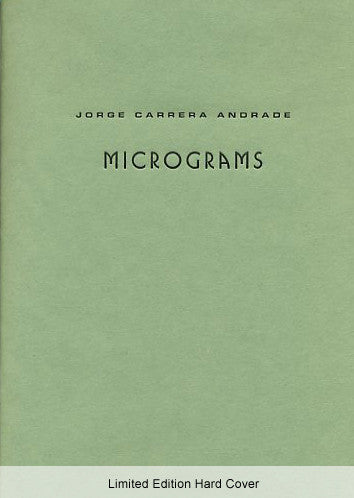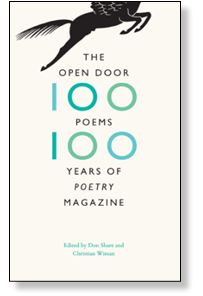Notable Books: Christine Deavel, Jorge Carrera Andrade, Ernst Miester, and The Open Door
NOTABLE BOOKS 2012

Christine Deavel’s Woodnote (Bear Star Press, 2011) is a remarkable book—a book about, among other things, the legacy of books. In vision, and as a physical object, it is a mindful handful: a big square picture window of a book, drawing together many styles. In five sections we encounter an acute, discerning lyricism (“Hidden / as a toy balloon in the sky is / and is not”), personal essay (“But to walk through it, to walk through the snow as it falls, is to walk through another’s memory, even if it is only the land’s”), excerpts of historical records (“The cessions are as follows: / … The December end of the portage place. / Also the overlapping voice of all the lakes”), and, importantly, selections from the diaries of a relative (“A gloomy day :: a delightful day :: A heavy frost but nice day”) who died the year the poet was born.
The cumulative effect of these styles is astounding. Piece by piece, in palimpsest, an image emerges, both vibrant and spectral, of a vanished place, a changing way of life. “Northern rural Indiana” and its ancient forests and native tribes loom behind the daily toil of early 20th century farm life and the speaker’s own childhood memories—yielding, not without ambivalence and telltale struggle (“I squirm to write this”), a self-perpetuating loop of communal revelation, the whole greater than its many moving parts. Woodnote gives us a poet working at every level of the text—precursor & creator, reader & reviser, editor & archivist—encompassing a veritable ecology of the written word as it records and informs daily life, and pushes into the realms of art. In struggling with her sources, her “desire to make,” Deavel manages to redefine and enlarge our sense of self—“you keep to be kept / watch to know watching”—and reassert the value of even the most humble words to carve out even a changeable place in the ravages of time. The book itself, coherent, collected, emerges as our best defense.

Last fall, Wave Books produced a marvelous three day festival of translation at the Henry Art Gallery in Seattle. Two books featured at that festival are well worth seeking out: Jorge Carrera Andrade’s Micrograms, and Ernst Meister’s In Time’s Rift. Unlike Deavel’s polyphonic sorting through legacies of print, each of these books deals exclusively in lyrical concision, the clarifying image or short-lined stanza poised against a sense of the infinite and the white space of the page. Both poets (Andrade is from Ecuador; Meister from Germany) lived and wrote in the early to mid 20th century, though neither engages directly with history or a specific sense of place. In Andrade’s case, brief “micrograms” (a word he coined to describe his pictographic form) and translations of haiku crystalize a sense of wonder. For Ernst Meister, the background noise is terror—our brief mortality swallowed up by the unknowable recesses of a universe which has no need of us.
Here’s Andrade’s “Macaw,” for instance, in its entirety: “The tropics patch together / golds and fires to make for him / a coat of flags.” Or “Alphabet”: “Bird are / God’s handwriting.” Andrade is a poet of swift, iconic materializations, which the translators (Joshua Beckman and Alejandro de Acosta) capture with lightning ease. Things of this world—snails, pears, oysters, blowflies, crickets—acquire an aura of equanimity that admits of a greater design. Another kind of palimpsest emerges in this book: Spanish to English, Japanese to Spanish, the language of metaphor subsuming mortality. Micrograms is a compact book with the macrocosm in its sights.
 For Ersnt Meister, our mortality cannot be subsumed, only confronted: “To be dead, what / a life, really, / at one with the worm’s / monotony…”. His lyrics (translations by Graham Foust and Samuel Frederick) read like existential ripcords, brief incantations aching to confirm our existence against the encroaching void. They read like Heidegger’s Being and Time distilled into shot glasses—dasein with its nose to the ground: “Nothingness wants / to conceal itself / in what is dead. / In this it is / quite real.” That fourth line-break is sly, and indicative both of Ernst’s method and the translators’ transparent care. As memento mori, these poems are chastening, but never downbeat. Time may get the better of us, but language, like care itself, is still a refuge of sorts: “I look at a window, / a square of sky. // You, dear, are still / my dwelling.”
For Ersnt Meister, our mortality cannot be subsumed, only confronted: “To be dead, what / a life, really, / at one with the worm’s / monotony…”. His lyrics (translations by Graham Foust and Samuel Frederick) read like existential ripcords, brief incantations aching to confirm our existence against the encroaching void. They read like Heidegger’s Being and Time distilled into shot glasses—dasein with its nose to the ground: “Nothingness wants / to conceal itself / in what is dead. / In this it is / quite real.” That fourth line-break is sly, and indicative both of Ernst’s method and the translators’ transparent care. As memento mori, these poems are chastening, but never downbeat. Time may get the better of us, but language, like care itself, is still a refuge of sorts: “I look at a window, / a square of sky. // You, dear, are still / my dwelling.”
In recent years, Wave has a made a point of publishing unadorned books which focus attention on the words alone. These two collections, each rippling with implication, exemplify the merits of that spare design. Indeed, for these incisive poems and their mirroring source languages, the physical book (another kind of being in time) deepens their affective range.

Is there a more fearful book than the anthology—that doorstop destined never to be read in its entirety, only leafed through, sampled intermittently? Well, The Open Door (University of Chicago Press, edited by Don Share and Christian Wiman) may change all that forever. In short, The Open Door is thrilling, an engaging read from cover to cover—simply as a book of poems, and also as an illuminating tour of the last 100 years of poetry in English. Culling from the century-deep annals of Poetry magazine, the editors have given us, with an ear not for complacent monumentality, but alive to the grace notes of serendipity and eclectic inclusion, a collection of poems that call to each other, in cunning and uncanny ways, across the decades.
From the opening pages, in which Pound’s famous indictum, In a Station of the Metro (printed in its original form, with spacing) gives way immediately to Kay Ryan’s “Sharks’ Teeth” (“Everything contains some / silence.”), our attention is drawn to the ways in which key elements of poetry (the image, in this case) play out in different styles. Likewise, the hard-nosed colloquial irony of August Kleinzahler’s “The Hereafter” looks back on the erudite arch-irony of Eliot’s emergent Prufrock. And so on. Commentary drawn from letters and essays, interspersed throughout, accentuates the feeling of being in a high-stakes conversation as ideas about art and audience ricochet around the mead hall. Imagine Ange Mlinko on a panel with Ezra Pound, etc. The colloquy ends, poetically, with Yeats’s meditation on connecting art to audience and place (“The Fisherman”) and editorially with Monroe’s own notes on audience in a democratic age. All told, this is a book that emphasizes the pleasures of reading while providing an expansive view of poetry’s readership, even as it reminds us how, in an age of proliferating text, a good editor can make all the difference.
—Kevin Craft
